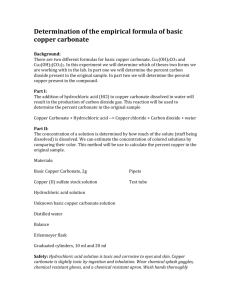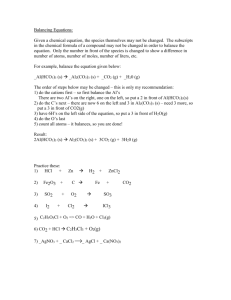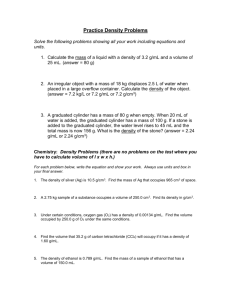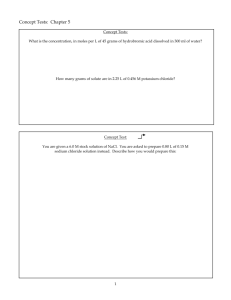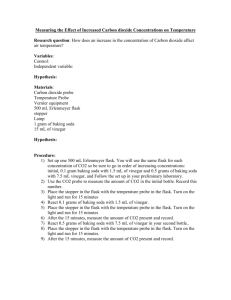Stoich. Day 1- Unknown Carbonate Lab Identifying an
advertisement
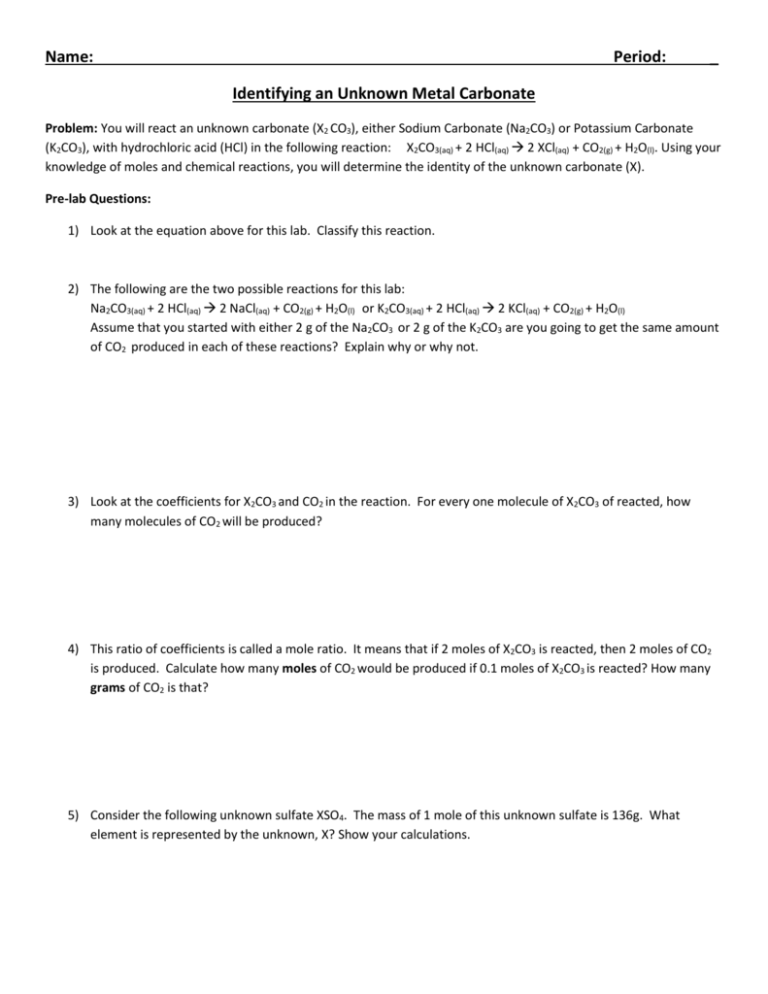
Name: Period: _ Identifying an Unknown Metal Carbonate Problem: You will react an unknown carbonate (X2 CO3), either Sodium Carbonate (Na2CO3) or Potassium Carbonate (K2CO3), with hydrochloric acid (HCl) in the following reaction: X2CO3(aq) + 2 HCl(aq) 2 XCl(aq) + CO2(g) + H2O(l). Using your knowledge of moles and chemical reactions, you will determine the identity of the unknown carbonate (X). Pre-lab Questions: 1) Look at the equation above for this lab. Classify this reaction. 2) The following are the two possible reactions for this lab: Na2CO3(aq) + 2 HCl(aq) 2 NaCl(aq) + CO2(g) + H2O(l) or K2CO3(aq) + 2 HCl(aq) 2 KCl(aq) + CO2(g) + H2O(l) Assume that you started with either 2 g of the Na2CO3 or 2 g of the K2CO3 are you going to get the same amount of CO2 produced in each of these reactions? Explain why or why not. 3) Look at the coefficients for X2CO3 and CO2 in the reaction. For every one molecule of X2CO3 of reacted, how many molecules of CO2 will be produced? 4) This ratio of coefficients is called a mole ratio. It means that if 2 moles of X2CO3 is reacted, then 2 moles of CO2 is produced. Calculate how many moles of CO2 would be produced if 0.1 moles of X2CO3 is reacted? How many grams of CO2 is that? 5) Consider the following unknown sulfate XSO4. The mass of 1 mole of this unknown sulfate is 136g. What element is represented by the unknown, X? Show your calculations. Materials: Unknown Metal Carbonate Electronic Balance 25 mL Graduated Cylinder 3 M Hydrochloric Acid (HCl) 125 mL Erlenmeyer flask Procedure: 1) 2) 3) 4) 5) 6) 7) 8) Mass the 125 mL Erlenmeyer flask and record the exact mass. In a weighing dish, mass approximately 2 g of the unknown metal carbonate. Record the exact mass. Transfer the unknown carbonate to the 125 mL Erlenmeyer flask. Use a 25 mL graduated cylinder and pour in 20 mL of the 3 M HCl. Measure the combined mass of the cylinder and the acid and record. *”3M” is a concentration, the M does not represent the metal* SLOWLY pour the HCl into the flask. Allow the reaction of the HCl and unknown carbonate to go to completion. Measure and record the mass of the empty cylinder after the HCl has been added to the flask. Once the reaction appears complete, swirl the flask to allow any further reaction to take place. (There should be no more solid in the bottom of the flask.) Measure the mass of the flask and its contents and record the mass. Repeat the procedure again for a second trial. Trial #1 Masses in g Trial #2 Masses in g Average Masses in g Mass of Flask Mass of X2CO3 Mass of Cylinder & 3M HCl Mass of empty graduated cylinder Mass of flask + reacted solution Calculations: Use the average mass and show your work for all of the following calculations. 1) Mass of 3M HCl used as a reactant. 2) Total mass of the original reactants in the flask before the reaction. (Flask + X2CO3 sample + 3M HCl) 3) Mass of released CO2 as a product. 4) Moles of CO2 released. 5) Moles of the unknown carbonate (X2CO3) reacted. 6) Molar mass (grams of 1 mole) of X2CO3 *hint you need to use the original mass you used of the X2CO3 in the calculation in a proportion. 7) Mass of element X. 8) Which element is X? 9) Calculate your percent error using your calculation of the mass of X, compared to the actual mass on the periodic table. (Remember: Percent Error = |Got-Shoulda|/Shoulda x 100 Processing questions: 1) To calculate the mass of 3M HCl used in the reaction you subtracted the original mass of the graduated cylinder plus 3M HCl from the mass of the empty graduated cylinder after you dumped the 3M HCl into the flask with the unknown carbonate. Why is this a more accurate measure of the 3M HCl used in the reaction than if you had measured the empty graduated cylinder first and then subtracted that from the mass of the graduated cylinder plus 3M HCl. 2) Why was the mass of the CO2 that was produced used in the calculations rather than the mass of the XCl produced? (Remember this was the equation for this reaction: X2CO3(aq) + 2 HCl(aq) 2 XCl(aq) + CO2(g) + H2O(l))
